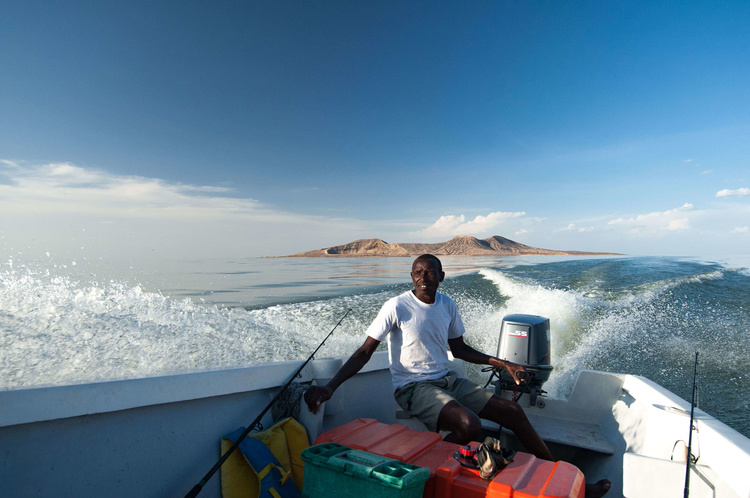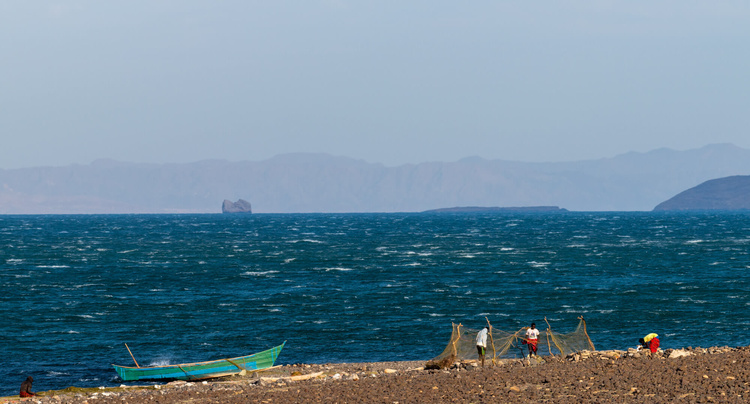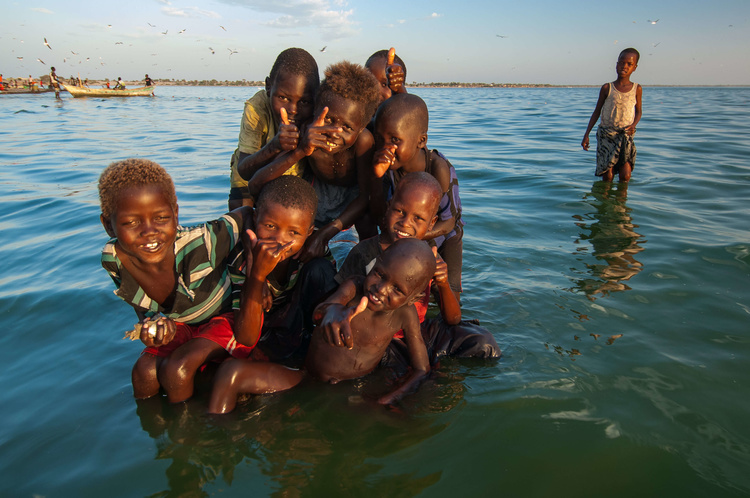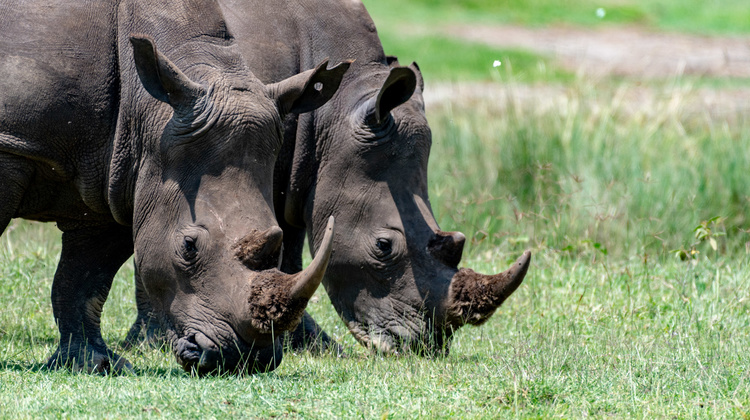Along the rift valley, from Lake Turkana to Nakuru
From US$6,028 per person
Itinerary
-
Day 1Nairobi-Kitale
Depart Nairobi and drive, with packed lunch, via Nakuru and Eldoret , with en route stopovers to view and experience the Great Rift Valley and panoramic views and far horizons to Kitale. Dinner and overnight at Aturukan Hotel.
-
Day 2Kitale-Lake Turkana
After an early breakfast drive, with packed lunch, through Cherangani Hills, the vast open desert land and among others, to Lodwar, the capital city of Turkana people, and onward to Eliye Springs Resort on the west side of Lake Turkana. Settle down, dinner and overnight.
-
Day 3Lake Turkana
Breakfast and morning at leisure, nature walk, bird walk or swim. Lunch and thereafter in the afternoon do a boat excursion to Central Island NP (UNESCO – world heritage site).
The world's largest desert lake, Lake Turkana is 250 km long and 60 km wide. Also known as the “Jade Sea”, it flows right up to the Ethiopian border. It has been a UNESCO World Heritage Site since 1997. Although the environment is dry and not very conducive to the development of vegetation, aquatic life is abundant. The Nile crocodile and the hippopotamus can be found here. The lake is fed by three rivers from Ethiopia. It is also the saltiest lake in Africa. The lake is drained by evaporation, which increases its salt content.
The undulating algae in its waters regularly change color, turning from gray to blue as the clouds pass overhead. On the surface, however, the lake is always bright green in the sunlight.
Lake Turkana is also the perfect place for sport fishing enthusiasts. You'll find the fearsome Nile Perch, which can grow up to 2 meters long and weigh 200 kg, or the tiger fish with its vampire-like teeth. -
Day 4Lake Turkana
After breakfast, with picnic lunch, drive to Nariokotome “Turkana Boy” site discovered by Dr. Leakey and back to Eliye Springs for sundowner.Turkana Boy, also called Nariokotome Boy, is the name given to fossil "KNM-WT 15000", a nearly complete skeleton of a Homo ergaster youth who lived 1.5 to 1.6 million years ago. This specimen is the most complete early hominin skeleton ever found. It was discovered in 1984 by Kamoya Kimeu on the bank of the Nariokotome River near Lake Turkana in Kenya. Estimates of the individual's age at death range from 7 to 11 years old.
-
Day 5Lake Turkana
Mini-breakfast and thereafter a cultural visit to Turkana Village or homestead and return to the camp for full breakfast. The rest of the morning at leisure and after an early lunch drive to Ferguson’s Gulf/Bay to visit by boat the Turkana fishing community to experience and witness their day-to-day activities there. A variety of water birds are also seen here including flamingo, an ideal paradise for birdwatchers. Return to Eliye Springs Resort for Sundowner, Turkana cultural dance, dinner and overnight.
-
Day 6Lake Turkana-Kitale
After an early breakfast and with packed lunch, drive via Lodwar and Cherangani Hills to Kitale, dinner and overnight Aturukan Hotel.
-
Day 7Kitale-Lake Baringo-Nakuru
Breakfast and with packed lunch drive via Eldoret, Iten, Kerio Valley and Lake Baringo (stopover) to Nakuru town. Overnight at Grand Winston Hotel
-
Day 8Nakuru-Nairobi
Breakfast and with packed lunch drive to Lake Nakuru National Park for morning game drive.
Lake Nakuru is frequented by flamingos and pelicans. This park is home to a rich fauna, including leopards, elephants, Rothschild's giraffe, white rhinoceros (easily observed) and reed antelope. Buffalo, waterbuck and lion complete this non-exhaustive list.
In the afternoon drive back to Nairobi, and end of our services.
Prices
Price conditions for your safari in Kenya
Price Per Person
Price Include
- Transport in private 4x4 land cruisers
- Unlimited kilometers
- Park entry fees
- Boat services on Lake Turkana
- Services of our professional English-speaking driver guide
- Local guides where necessary
- Drinking water (refer below)
- Hotel accommodation on Full Board basis sharing room (refer below)
Not Included in the Price
- Visa fee
- International flight
- Transfers were not applicable
- Travel and cancellation/medical insurance cover
- Hotel accommodation in Nairobi
- Single Room (under single Supplement terms)
- Beverages, Alcohol, Spirits
- Reusable Water Bottle for refilling (Very Important)
- Photographic fee with the local people
- Eventual tips
- Any items or expenses of personal nature
- Any other items not mentioned in the inclusions
Travel info
Here is
some practical information for your safari in Kenya
Accommodation
during your safari in Kenya
Transport in safari
Other
Useful Information to travel in Kenya
- No plastic bags in to Kenya
- No plastic bottles in the Game Parks and Reserves
- Carry your COVID Vaccination Certificate
Entry requirements for Kenya
- Mandatory passport valid 6 months after your return date
- Since January 4, 2024, entry to Kenya has been subjected to an electronic travel authorisation (ETA), in place of a visa.
Sanitary conditions for Kenya
- Yellow fever
- Malaria
- Consult your GP or an International Vaccination Centre to assess your state of health and receive health recommendations, particularly concerning vaccinations
- Set up a personal pharmacy
Climate
What to Pack
- Good quality sandals
- Good quality light walking shoes
- Casual shoes for evenings
- Light boots for your own comfort in the evening
- Fleece jacket
- Practical safari jacket
- Lightweight waterproof rain jacket, windbreaker or fleece jacket
- T-shirts-Short and long sleeve shirts or blouses
- Shorts and long casual trousers
- Casual light dresses or skirts
- Enough underwear, socks and hankies
- Bathing suits
- Toiletries, lip balm and scarves
- Miniature wet towel and Kleenex (enough)
- Small backpack
- Small reusable water bottle
- Small flashlight or headlamp (important)
- Hat with 'shin cord' to avoid blowing away and a safari hat or cap (important)
- Important Quality mosquito/insect repellent (for body)
- Waterproof sun blocker cream/sunscreen
- Personal medication
- Good quality sunglasses
- Binocular and Guidebooks
- Camera with extra battery and memory card
- Adventure spirit, Patience, Energy and Good sense of Humour







